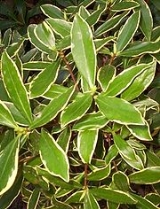
Daphne odora
Encyclopedia
Daphne odora is an evergreen
shrub, grown for its very fragrant, fleshy, pale-pink, tubular flowers, each with 4 spreading lobes, and for its glossy foliage. It rarely fruits, but when it does, it produces red berries after flowering.
D. odora is native to China
and Japan
, and grows best in fertile, slightly acid, peaty, well-drained soils. It grows in full sun or partial shade, and is hardy to -10 celsius, possibly lower. In Japan, the plant is more commonly known as Jinchoge.
Plants are not long lived, senescing
within 8 to 10 years. Daphne generally do not react well to root disturbance, and may transplant badly. D. odora is also susceptible to virus infection, which causes leaf mottling.
Daphne odora is propagated by semi-ripe cuttings in summer.
Evergreen
In botany, an evergreen plant is a plant that has leaves in all seasons. This contrasts with deciduous plants, which completely lose their foliage during the winter or dry season.There are many different kinds of evergreen plants, both trees and shrubs...
shrub, grown for its very fragrant, fleshy, pale-pink, tubular flowers, each with 4 spreading lobes, and for its glossy foliage. It rarely fruits, but when it does, it produces red berries after flowering.
D. odora is native to China
China
Chinese civilization may refer to:* China for more general discussion of the country.* Chinese culture* Greater China, the transnational community of ethnic Chinese.* History of China* Sinosphere, the area historically affected by Chinese culture...
and Japan
Japan
Japan is an island nation in East Asia. Located in the Pacific Ocean, it lies to the east of the Sea of Japan, China, North Korea, South Korea and Russia, stretching from the Sea of Okhotsk in the north to the East China Sea and Taiwan in the south...
, and grows best in fertile, slightly acid, peaty, well-drained soils. It grows in full sun or partial shade, and is hardy to -10 celsius, possibly lower. In Japan, the plant is more commonly known as Jinchoge.
Plants are not long lived, senescing
Senescence
Senescence or biological aging is the change in the biology of an organism as it ages after its maturity. Such changes range from those affecting its cells and their function to those affecting the whole organism...
within 8 to 10 years. Daphne generally do not react well to root disturbance, and may transplant badly. D. odora is also susceptible to virus infection, which causes leaf mottling.
Daphne odora is propagated by semi-ripe cuttings in summer.
Cultivars
- D. odora f. Rosacea has white and pink flowers.
- D. odora f. Rubra has dark red-pink flowers with reduced fragrance.
- D. odora 'Aureomarginata' has yellow edged leaves, and is hardier and more suitable to cultivation than the plain-leaved forms .

